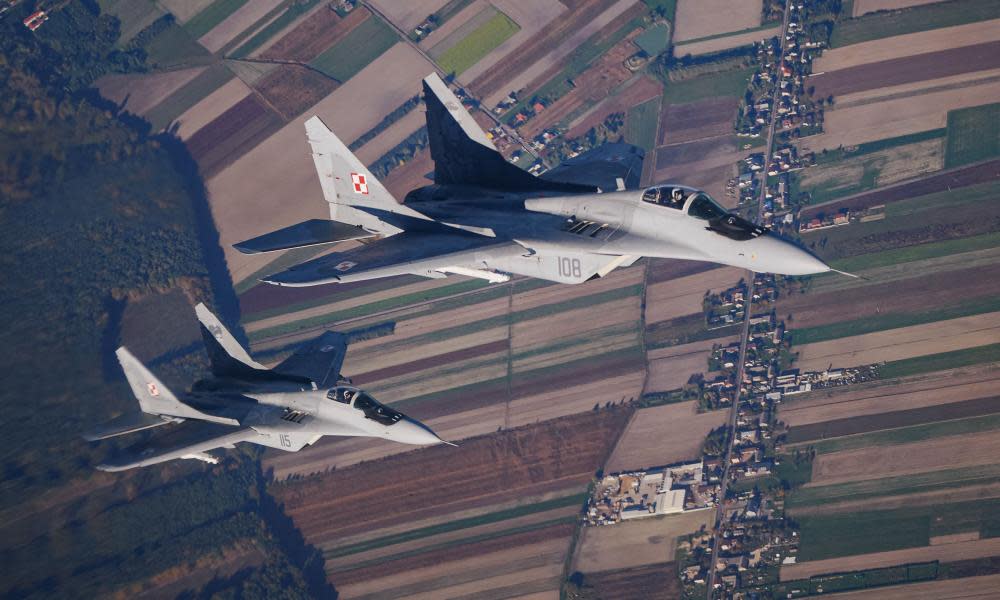Poland to deliver fighter jets to Ukraine in major escalation of military backing

Poland will become the first country to deliver fighter jets to Ukraine in the next few days, marking a significant upward step in military backing for Kyiv ahead of an expected counter-offensive.
The precedent, involving four Soviet-era MiG-29s as a first instalment, could lead to other Nato members providing warplanes, a longstanding Ukrainian request.
Related: Zelenskiy steps up jets lobbying – but are RAF Typhoons what Ukraine needs?
The Polish president, Andrzej Duda, made the announcement in Warsaw. He said the first planes being handed over were inherited from East Germany after the fall of the Berlin Wall.
Duda said the MiGs were coming to the end of their working lives after 30 years, but were “still in working order”. The president said that more Polish MiGs were being serviced and repaired in preparation for being handed to Ukraine. In all, Poland has 28 MiG-29s which are to be replaced over the next few years by South Korean FA-50s and US F-35s.
Until now, Ukraine’s backers in Nato have only provided spare parts for its fleet of Soviet-era warplanes, amid fears that delivering functioning planes to Ukraine would be seen by Moscow as direct participation in the war. A year ago, Poland offered to hand over all its MiGs to the US at its airbase in Ramstein, Germany, so they could be passed on to Ukraine, but Washington rejected the plan.
Slovakia, Finland and the Netherlands have all said they would consider supplying Ukraine with warplanes. The US and UK have so far refused to supply their F-16s and Typhoon combat aircraft respectively, on the grounds that they require too much training, ground support and long, smooth runways to be of any short-term help to Ukraine. However, the UK has offered to provide air cover for any eastern European country willing to supply Kyiv with Soviet-era jets.
Some European countries have adopted a policy of ambiguity over what they might provide if Russia sustains its war in Ukraine over the long term.
“The experience of the last 12 months is that what was considered impossible, too dangerous, potentially escalatory, useless in terms of Ukrainian needs and so on, has proven to be absolutely necessary and urgent a few months later,” one senior European official said. “So we are pragmatic and we think it is necessary to make sure that, seen from Moscow, there is a cloud of uncertainty about what kind of military support could come if this war was to span over several years.”
Ukraine is expected to attempt to make a military breakthrough in the spring and summer and is trying to build a well-equipped force with western-trained recruits and western-supplied weapons. But deliveries of Leopard tanks and other equipment have been slower than Kyiv had hoped, and its army has lost many of its experienced soldiers in the battle of attrition under way on the eastern front.
The Polish announcement came a day after a virtual conference of defence ministers from over 40 countries supporting Ukraine, to coordinate the next tranche of armaments shipments. Sweden announced that it would be sending 10 Leopard tanks and Norway and the US offered two more of their jointly developed Nasams anti-aircraft systems.
“We’re generating combat power to a degree that we believe will provide them opportunities to change the dynamics on the battlefield,” said the US defence secretary, Lloyd Austin.
Oleksii Reznikov, the Ukrainian defence minister, said this week that the success of the Ukrainian counteroffensive would hinge on forcing the Russian military on to the defensive, disrupting enemy supply lines and neutralising their air superiority. To that end, Reznikov said, the supply of fighter jets would accelerate the liberation of Ukrainian territory.
“The sooner we get combat aircraft, the more human lives will be saved,” Reznikov said.

 Yahoo News
Yahoo News 
